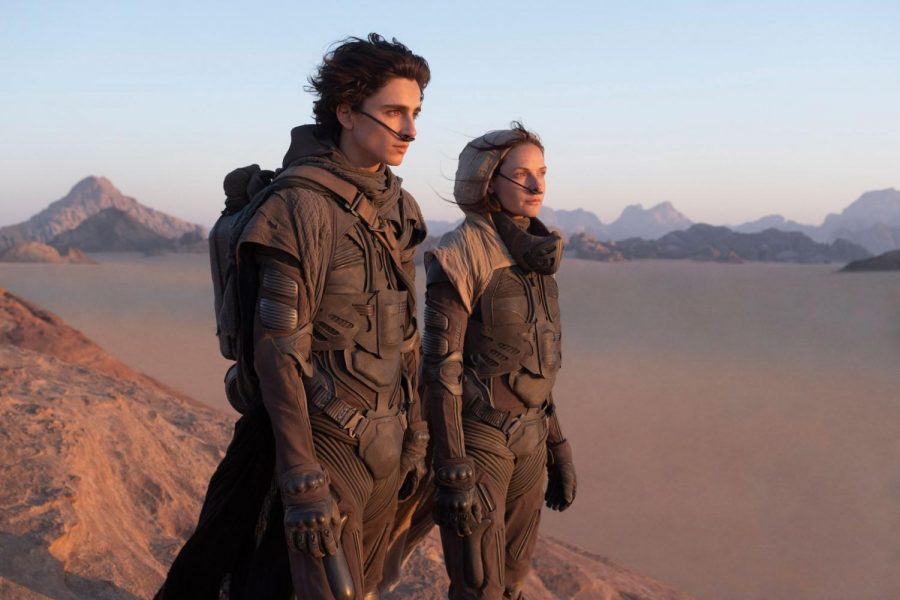Now Showing: Dune
Dust, spice and fire congest both the sky and ground. Mysteriously draped warriors emerge from the sands as the sound from their rifles are muffled by a mixture of explosions and towering metal monstrosities. Within the span of just a little over two minutes of eye-catching visuals, the verdict is clear: Dune is worth the watch.
Though once considered unadaptable, director Denis Villeneuve did author Frank Herbert’s magnum opus, “Dune,” justice in his rendition of the science fiction cult classic.
In 1984, an adaptation of “Dune,” directed by David Lynch, was released and went down as one of the most disappointing sci-fi adaptations in film history. In contrast to its predecessor, Villeneuve’s take on the “Dune” franchise provides enough context for those unfamiliar with the series to still enjoy it, while simultaneously meeting the expectations of die-hard fans.
“Dune” takes place in the year 10191, with its protagonist, Paul Atreides (Timothée Chalamet), being the heir to the only known planet that can provide an addictive and highly valuable narcotic known as “the spice.” The story follows Atreides through his journey of navigating the deserted planet of Arrakis, dealing with internal conflicts of his family and his assimilation into the planet’s indigenous tribe—the Fremen. More details on the Fremen will most likely be revealed in the coming sequel, and the movie ending, without a proper conclusion, has been a problem for many.
A particular gripe some have expressed with the film is its lack of a proper climax and its overall narrative direction. Typically storylines follow three acts: the setup, the confrontation of the issue and the resolution. But, with “Dune,” the entirety of its two and a half hour span essentially serves as context to the main plot; its abrupt ending doesn’t help either, as the film rolls to credits as soon as the storyline begins heating up.
Understandably, the contents of the 900 page book can’t all be covered in a single movie and requires substantial world building for its actual climax to be effective. But, the lack of proper advertising for the film—labelling it as “Dune” rather than “Dune: Part 1”—misconstrued its contents so that viewers may have left the screening feeling that they did not get everything they were promised.
Villenueve somewhat circumvents the lack of climax by utilizing composer Hans Zimmer’s atmospheric score and director of photography Greig Fraiser’s beautifully shot scenery. The overwhelming visuals and moving soundtrack work in tandem with one another to create a sense of euphoria in whoever’s watching.
The visuals even manage to walk the thin line between grandeur and pompous, knowing when to buy into thrill-inducing sequences while also toning down its intensity in the more subdued scenes. The overwhelming amount of thought put into each scene is expressed through how well the details of the book were translated from paper to screen. An example would be how Arrakis’ deserted, barren landscape penned out exactly as one would have imagined and the daunting sense of scale when seeing massive spaceships being dwarfed by even larger Guild transport ships, leaving audiences in complete awe.
One of the most interesting and playful expansions on the novel’s descriptions were the way Thopters, a kind of ship, were designed. Initially described as common-class, small ships that could fit up to six people, they were translated on-screen into helicopters that resembled dragonflies with retractable wings. Those small details truly breathe life into “Dune” and help to make the whole thing feel that much closer to reality.
The auditory aspect to “Dune” is just as impressive as its visual design. Hans Zimmer’s mix of swelling strings and intense choral interludes build an exceptionally ominous atmosphere, making the soundtrack sound just as dark as the film itself.
In fact, the artistic appeal of the entire film nearly detracts from the star-studded roster of A-listers that make up the film’s cast. In spite of having great performances, namely Duke Leto (Oscar Issac) and Duncan Idaho (Jason Momoa), the sheer marathon of narrative material that Villenueve had to cover made it seem like some actors were underutilized and only there to bridge a sense of continuity in the sequel.
However, this lack of screentime is largely due to their role and the story’s pacing. Many of the characters who are associated with the Fremen are either briefly alluded to in Paul’s visions or only make an appearance in the concluding duel as they will play larger roles in the sequel of the film, which is set to premier in Oct. 2023.
There are hardly any complaints with the casting of the movie. Chalamet, despite not being as young as Paul in the books, was the perfect choice to portray him on-screen; his confused and brooding attitude was perfect for the role of a sheltered heir turned a noble family justice. Momoa’s performance as Duncan Idaho was also one that grabbed my attention; his outstanding charisma and camaraderie with Chalamet’s character offered a different side to his character and enhanced his overall characterization.
If the sequel manages to match the high standards set by this first film, then “Dune” may very well go down as one of the best science fiction adaptations of all time. In the meantime, “Dune: Part One” can serve as a gateway to those interested in reading the books, or just be a meaningful watch for anyone who hasn’t heard of the series.
Your donation will support the student journalists of Diamond Bar High School. Your contribution will allow us to purchase equipment and cover our annual website hosting costs.









